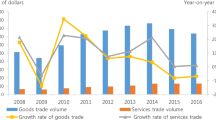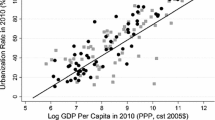Abstract
The role of spillover effect of transportation endowment on regional economic development is analyzed in this paper. We adopt the reduced form from the Solow growth model to estimate spillover effect from transportation. The panel database in use incorporates provincial gross regional product (GRP), labor and capital supply, and transportation investment information from 1985 to 2012 in China. The results confirm positive and significant spillover effect in Chinese provinces. In this paper, non-homogeneous spillover effects are captured in the empirical regression by the use of spatial weighing methods based on provincial economics and similarity as well as geographic connection. Highly positive spillovers are observed between economically similar provinces. However, for those under-developed provinces, high network connectivity often results in low or negative spillovers. The mobility and migration of production factors are believed to be the sources of the negative spillovers, while the industrial reallocation and market expansion contribute to the positive spillovers.



Similar content being viewed by others
References
Álvarez-Ayuso IC, Delgado-Rodriguez MJ (2012) High-capacity road networks and spatial spillovers in Spanish regions. J Transp Econ Pol 46(2):281–292
Álvarez-Ayuso IC, Condeço-Melhorado AM, Gutiérrez J, Zofío JL (2014) Integrating network analysis with the production function approach to study the spillover effects of transport infrastructure. Regional Studies, (ahead-of-print), p 1–20
Aschauer DA (1989) Is public expenditure productive? J Monet Econ 23(2):177–200
Banister D, Berechman J (2001) Transport investment and the promotion of economic growth. J Transp Geogr 9(3):209–218
Batabyal AA, Nijkamp P (2014) Innovation, decentralization, and planning in a multi-region model of schumpeterian economic growth. Netw Spat Econ 14(3–4):605–628
Berechman J, Ozmen D, Ozbay K (2006) Empirical analysis of transportation investment and economic development at state, county and municipality levels. Transportation 33:537–551
Boarnet MG (1996) The direct and indirect economic effects of transportation infrastructure. Working paper No.340. The Transportation Center, University of California, Berkeley, CA
Boarnet MG (1998) Spillovers and the location effects of public infrastructure. J Reg Sci 38(3):381–400
Cantos P, Gumbau-Albert M, Mandos J (2005) Transport infrastructures, spillover effects, and regional growth: evidence of the Spanish case. Transp Rev 25(1):25–50
Caschili S, Medda FR, Wilson A (2015) An interdependent multi-layer model: resilience of international networks. Netw Spat Econ. doi:10.1007/s11067-014-9274-2, On-Line First
Davoodi H, Zou HF (1998) Fiscal decentralization and economic growth: a cross-country study. J Urban Econ 43(2):244–257
De la Fuente A (2000) Infrastructure and productivity: a survey. Instituto de Análisis Económico, Barcelona
Fujita M, Krugman P, Venables AJ (1999) The spatial economy, cities, regions, and international trade. The MIT Press, Cambridge
Goldsmith SB (1951) A perpetual inventory of national wealth. Stud Income Wealth 14:5–74
Gramlich EM (1994) Infrastructure investment: a review essay. J Econ Lit 32:1176–1196
Griffith DA, Chun Y (2014) Spatial autocorrelation in spatial interactions models: geographic scale and resolution implications for network resilience and vulnerability. Netw Spat Econ. doi:10.1007/s11067-014-9256-4, On-Line First
Gutierrez J, Condeco-Melhorado A, Lopez E, Monzon A (2011) Evaluating the European added value of TEN-T projects: a methodological proposal based on spatial spillovers, accessibility and GIS. J Transp Geogr 19:840–850
Hausman JA (1978) Specification tests in econometrics. Econometrica 46(6):1251–1271
Hu A, Liu S (2010) Transportation, economic growth and spillover effects: the conclusion based on the spatial econometric model. Front Econ China 5(2):169–186
Krugman P (1991) Increasing returns and economic geography. J Polit Econ 99:483–499
Levine R, Renelt D (1992) A sensitivity analysis of cross-country growth regressions. Am Econ Rev 82(4):942–963
Liu Y (2010) Transport infrastructure investment, regional economic growth and the spatial spillover effects-based on highway and marine’s panel data analysis. China Ind Econ 12:37–46
Liu N, Chen Y, Zhou Q (2007) Spatial spillover effects of transport infrastructure on regional economic growth. J Southeast Univ 23:33–39
Marx K, Engels F (1904) Das Kapital: Kritik der politischen Ökonomie (Vol. 3). O. Meissner
Mas M, Maudos J, Perez F, Uriel E (1994) Captial public y productividad de las Regiones Espanolas. Moneda Credito 198:163–192
Mas M, Maudos J, Perez F, Uriel E (1996) Infrastructures and productivity in the Spanish regions. Reg Stud 30(7):641–649
Moreno R, López-Bazo E (2007) Returns to local and transport infrastructure under regional spillovers. Int Reg Sci Rev 30(1):47–71
Munnell AH (1990) How does public infrastructure affect regional economic performance? N Engl Econ Rev (September/October), pp 11–32
Munnell AH (1992) Policy watch: infrastructure investment and economic growth. J Econ Perspect 6(4):189–198
Naughton B (2002) Provincial economic growth in China: causes and consequences of regional differentiation. In: Renard M-F (ed) China and its regions: economic growth and reform in Chinese Provinces. Edward Elgar, Northampton, pp 57–86
Ozbay K, Ozmen D, Berechman J (2007) Contribution of transportation investments to county output. Transp Policy 14(4):317–329
Pellegrini G (2002) Proximity, polarization, and local labor performances. Netw Spat Econ 2:151–173
Peng W (2008) The influence of capital flow on Chinese three regional economic gap. Ph.D. Dissertation. Fudan University
Percoco M (2004) Infrastructure and economic efficiency in Italian regions. Netw Spat Econ 4:361–378
Pittman R (2004) Chinese railway reform and competition: lessons from the experience in other countries. J Transp Econ Pol 38(2):309–332
Reggiani A, Nijkamp P (2006) Spatial dynamics, networks and modelling. Edward Elgar Publishing, Northampton
Smith A (1863) An inquiry into the nature and causes of the wealth of nations. A. and C. Black, Edinburgh
Solow RM (1956) A contribution to the theory of economic growth. Q J Econ 70(1):65–94
Stigler GJ (1951) The division of labor is limited by the extent of the market. J Polit Econ 59(3):185–193
Taplin JHE (1993) Economic reform and transport policy in China. J Transp Econ Pol 27(1):75–86
Wang F, Guo S, Jiang Q (2010) Labor migration and regional development in China: a regional CGE analysis. http://www.cenet.org.cn/cn/CEAC/2005in/jl023.pdf. Accessed on-line on 21st Jan 2014
Waters WG (2004) Empirical studies of infrastructure investment and economic activity: evidence from Canada. World Conference on Transport Research, Istanbul
Xie F, Levinson D (2009) Jurisdictional control and network growth. Netw Spat Econ 9(3):459–483
Xiong C, Zhang L (2013) Deciding whether and how to improve statewide travel demand models based on transportation planning application needs. Transp Plan Technol 36(3):244–266
Xiong C, Zhu Z, He X, Chen X, Zhu S, Mahapatra S, Chang GL, Zhang L (2015) Developing a 24-hour large-scale microscopic traffic simulation model for the before-and-after study of a new tolled freeway in the Washington, DC–Baltimore Region. J Transp Eng 141(6), 0501500
Yu N, de Jong M, Storm S, Mi J (2013) Spatial spillover effects of transport infrastructure: evidence from Chinese regions. J Transp Geogr 28:56–66
Zhang J, Wu G, Zhang J (2004) The estimation of China’s provincial capital stock: 1952–2000. Econ Res 10:35–44
Zhang J, Gao Y, Fu Y, Zhang H (2007) Why does China enjoy so much better physical infrastructure? Econ Res 4(3):4–19
Zhang L, Southworth F, Xiong C, Sonnenberg A (2012) Methodological options and data sources for the development of long-distance passenger travel demand models: a comprehensive review. Transp Rev 32(4):399–433
Acknowledgments
This research is financially supported by Center of Cooperative Innovation for Beijing Metropolitan Transportation with Grant T14H100041 for Dr. Chunfu Shao. The opinions in this paper do not necessarily reflect the official views of the sponsor. They assume no liability for the content or use of this paper. The authors are solely responsible for all statements in this paper. The authors are grateful to the two anonymous reviewers for their constructive comments and suggestions.
Author information
Authors and Affiliations
Corresponding author
Appendix
Appendix
Rights and permissions
About this article
Cite this article
Jiang, X., Zhang, L., Xiong, C. et al. Transportation and Regional Economic Development: Analysis of Spatial Spillovers in China Provincial Regions. Netw Spat Econ 16, 769–790 (2016). https://doi.org/10.1007/s11067-015-9298-2
Published:
Issue Date:
DOI: https://doi.org/10.1007/s11067-015-9298-2




